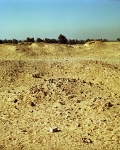Kom el-Hammam
Archaeology »
Archaeological Monuments » Kom el-Hammam
Kom el-Hammam - Egypt
Kom el-Hammam is located in Philadelphia,Faiyum.
Kom el-Hammam monument was established on 1900.
Primary threats to Kom el-Hammam :
The Greece-Roman town of Philadelphia was situated on the eastern edge of the Faiyum’s cultivated land and like the nome it was dedicated to Arsinoe, the sister of Ptolemy II, Philadelphus, who founded the community.
Historical facts of Kom el-Hammam :
- Kom el-Hammam, also known as The Mound of the Bath, is an archaeological site located near the modern city of Faiyum in Egypt. It is a significant historical site that provides valuable insights into the ancient Egyptian civilization. Here are some key historical facts about Kom el-Hammam:
- Ancient City : Kom el-Hammam was once a bustling city during the time of the pharaohs. It was primarily inhabited during the Middle Kingdom period (2055-1650 BCE) and continued to be occupied in subsequent periods.
- Strategic Location : The site's location was strategically chosen due to its proximity to Lake Qarun and the fertile lands of the Faiyum Oasis. It served as an important center for agriculture and trade, connecting the Nile Valley to the western desert regions.
- Ruins and Layout : The remains of Kom el-Hammam cover an area of about 1.5 square kilometers. The site contains the remains of various structures, including residential buildings, temples, and a large bath complex, from which the site derives its name.
- The Bath Complex : The most significant feature of Kom el-Hammam is the extensive bath complex that was discovered there. The complex consists of a series of rooms, including changing rooms, bathing areas, and underground heating chambers known as hypocausts. It reflects the importance of bathing and hygiene in ancient Egyptian society.
- Wall Paintings and Inscriptions : Many of the buildings at Kom el-Hammam were adorned with elaborate wall paintings and inscriptions. These decorations depict scenes from daily life, religious rituals, and mythical narratives. They provide valuable insights into the beliefs, customs, and artistic styles of the ancient Egyptians.
- Deir el-Medina Connection : Kom el-Hammam is believed to be connected to the nearby village of Deir el-Medina, which was the residence of the artisans who worked on the royal tombs in the Valley of the Kings. It is speculated that Kom el-Hammam may have served as a place of rest and relaxation for these workers.
- Excavations and Discoveries : Excavations at Kom el-Hammam began in the late 1980s and have continued intermittently since then. Archaeologists have uncovered numerous artifacts, including pottery, tools, jewelry, and statues, shedding light on various aspects of ancient Egyptian life.
- Worship of Sobek : One of the notable discoveries at Kom el-Hammam is a temple dedicated to the crocodile god Sobek. Sobek was associated with fertility, protection, and the Nile's annual flooding. The presence of this temple indicates the importance of Sobek worship in the region.
- Roman Influence : In addition to its ancient Egyptian history, Kom el-Hammam also has evidence of Roman occupation. Roman-style buildings and artifacts have been found at the site, suggesting that it continued to be inhabited and influenced by different cultures over time.
- Preservation and Tourism : Today, Kom el-Hammam is a protected archaeological site, managed by the Supreme Council of Antiquities in Egypt. Visitors can explore the ruins and gain insights into the daily life and cultural practices of the ancient Egyptians.
- In conclusion, Kom el-Hammam is a historically significant site that offers a glimpse into the ancient Egyptian civilization. Its well-preserved ruins, including the bath complex and the temple of Sobek, provide valuable archaeological evidence and contribute to our understanding of ancient Egyptian culture, society, and religious practices.

